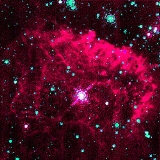
Pistol Star
Overview
Hypergiant
A hypergiant is a star with a tremendous mass and luminosity, showing signs of a very high rate of mass loss.-Characteristics:...
and is one of the most luminous known stars in the Milky Way
Milky Way
The Milky Way is the galaxy that contains the Solar System. This name derives from its appearance as a dim un-resolved "milky" glowing band arching across the night sky...
Galaxy.
It is one of many massive young stars in the Quintuplet cluster
Quintuplet cluster
The Quintuplet cluster is a dense cluster of massive young stars near the Galactic Center . Its name comes from the fact it has five prominent supergiant stars residing in it. Along with the Arches cluster it is one of two in the immediate GC region...
in the Galactic Center region.
The star owes its name to the shape of the Pistol Nebula
Pistol Nebula
The Pistol Nebula surrounds one of the most massive stars known, the Pistol Star. Both are located 25,000 light years away from Earth, near the center of the Milky Way galaxy. The nebula contains approximately 10 solar masses worth of ionized gas that was ejected by the star several thousand years...
, which it illuminates.
It is located approximately 25,000 light years from Earth in the direction of Sagittarius
Sagittarius (constellation)
Sagittarius is a constellation of the zodiac, the one containing the galactic center. Its name is Latin for the archer, and its symbol is , a stylized arrow. Sagittarius is commonly represented as a centaur drawing a bow...
.
It would be visible to the naked eye as a fourth magnitude
Apparent magnitude
The apparent magnitude of a celestial body is a measure of its brightness as seen by an observer on Earth, adjusted to the value it would have in the absence of the atmosphere...
star, if it were not for the interstellar dust
Interstellar medium
In astronomy, the interstellar medium is the matter that exists in the space between the star systems in a galaxy. This matter includes gas in ionic, atomic, and molecular form, dust, and cosmic rays. It fills interstellar space and blends smoothly into the surrounding intergalactic space...
that completely hides it from view in visible light.
The Pistol Star was discovered by the Hubble Space Telescope
Hubble Space Telescope
The Hubble Space Telescope is a space telescope that was carried into orbit by a Space Shuttle in 1990 and remains in operation. A 2.4 meter aperture telescope in low Earth orbit, Hubble's four main instruments observe in the near ultraviolet, visible, and near infrared...
in the early 1990s.
The star is thought to have ejected almost 10 solar mass
Solar mass
The solar mass , , is a standard unit of mass in astronomy, used to indicate the masses of other stars and galaxies...
es of material in giant outbursts perhaps 4,000 to 6,000 years ago (as observed from Earth).
Its stellar wind
Stellar wind
A stellar wind is a flow of neutral or charged gas ejected from the upper atmosphere of a star. It is distinguished from the bipolar outflows characteristic of young stars by being less collimated, although stellar winds are not generally spherically symmetric.Different types of stars have...
is over 10 billion times stronger than the Sun's.
Its exact age and future are not known, but it is expected to end in a brilliant supernova
Supernova
A supernova is a stellar explosion that is more energetic than a nova. It is pronounced with the plural supernovae or supernovas. Supernovae are extremely luminous and cause a burst of radiation that often briefly outshines an entire galaxy, before fading from view over several weeks or months...
or hypernova
Hypernova
Hypernova , also known as a type 1c Supernova, refers to an incredibly large star that collapses at the end of its lifespan...
in 1 to 3 million years.
Some astronomers conjecture that its large mass may be related to its location near the Galactic Center
Galactic Center
The Galactic Center is the rotational center of the Milky Way galaxy. It is located at a distance of 8.33±0.35 kpc from the Earth in the direction of the constellations Sagittarius, Ophiuchus, and Scorpius where the Milky Way appears brightest...
, since the star formation process there may favor massive objects.
Early reports suggested that it might be the most luminous star known, producing almost 100 million times as much power as the Sun
Sun
The Sun is the star at the center of the Solar System. It is almost perfectly spherical and consists of hot plasma interwoven with magnetic fields...
.
Later studies, however, have reduced its estimated luminosity to roughly 4 million times that of the Sun, making it a luminous blue variable
Luminous blue variable
Luminous blue variables, also known as S Doradus variables, are very bright, blue, hypergiant variable stars named after S Doradus, the brightest star of the Large Magellanic Cloud. They exhibit long, slow changes in brightness, punctuated by occasional outbursts in brightness during substantial...
about one-third as luminous as the binary star system Eta Carinae.
Even so, it radiates about as much energy in 20 seconds as does the Sun in a year.
Objects in this class have 80 to 150 times the mass of the Sun and lifetimes of only a few million years.
Unanswered Questions

